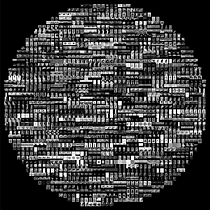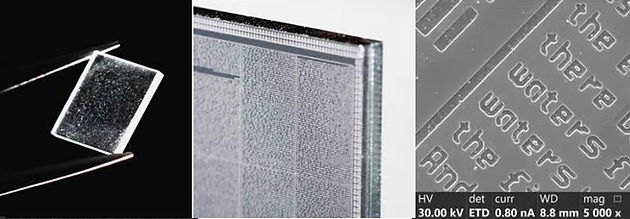TIME CAPSULE ARCHIVES

ARCHIVING ARTS AND CULTURE
The Lunar Codex uses digital and analog technology to preserve art, books, music, film, and more.
The costs of launching a payload into space, or to the Moon, depend highly on the weight and volume of the payload. If you're archiving hundreds of thousands of artifacts, you really want to compress this into as small a space as you can.
▪ Digital archives means the text or pictures have to be encoded onto the archival medium using an algorithm, or codec. To view, the artifact requires the reverse codec. While the most space-efficient strategy, viewing the archived data not straightforward. Digital archives also typically do not have longevity.
▪ Analog archives means that, to the human eye, text archives look like text, and photo archives look like photos. Decoding is straightforward - you view the artifact, with some magnification if necessary. Depending on the medium, analog archives may also provide ultra-long-term storage. However, one trade-off is that this strategy often requires more payload space than digital.
The Lunar Codex consists of both digital and analog archives, and uses several types of archival media to accomplish this:
▪ Etched metal, in the form of either silver or nickel discs, nickel or gold microfiche, which store data in analog format
▪ Ceramic-glass memory, with the ability to store, currently, in digital format, and in the future, in analog
▪ Quartz nanochips, storing data in analog format
▪ Semiconductor memory, such as micro secure digital or solid-state devices, which are digital storage devices, with radiation and thermal shielding
We also use redundancy to mitigate data loss - duplicating our files in both digital and analog formats, and incorporating several copies within one archive launch, or over multiple launches.
Etched Metal Technology
The simplest analog technology we use are etched solid metal discs - silver in the case of our Peregrine archive, and nickel in our Polaris archive. Both archives also included other technologies.
Nanofiche technology - conceptually similar to microfiche but with the fragile polymer film replaced by a robust thin metal - is a key technology used in our Nova, Serenity, Polaris, and Freya time capsules, again in tandem with other technologies. Nickel-based Nanofiche is our medium of choice for resilient, longevity-targeted applications.
Nanofiche stores orders of magnitude more content in the same space as microfiche. It is impervious to temperature and humidity, and has a near-zero degradation factor.
As an archival medium in terrestrial applications, it can be expected to last for hundreds of thousands of years, if not more.
On the Moon, in the absence of atmospheric erosion and other terrestrial influences, archives of Nanofiche could last millions of years, possibly limited only by the stability of the Earth-Moon system, which is counted in billions of years.
The image on the left shows a nickel-based Nanofiche circle the size of a quarter, one of eight from layer 14 of a 16-layer disc stack. This particular circle contains the Nova collection of the Lunar Codex. The disc contains hundreds and hundreds of small square image, each 2Kx2K pixels in size, in sets of three - one channel each for red, blue, and green (RBG).
As Incandence supported development of this technology, of the 8x15 NanoFiche collections in this stack, only the Lunar Codex's RGB collection has been proven decodable for full-color reproduction.


The RGB channels can be re-combined - as shown below - into a multicolor reproduction of the original piece.
The multi-channel Nanofiche technology for color reproduction was developed during processing of the Lunar Codex archive, and is used for the first time ever for our archive.
While art is saved as multiple RGB files, poetry and other text is saved as a single-channel image per page. Music is saved on Nanofiche as a waveform and spectral decomposition image, as sheet music, or as hex-encoded MIDI files; other formats such as WAV or MP4 are saved digitally, as is video, and not on Nanofiche.
To further illustrate how Nanofiche technology can miniaturize high-resolution images, the photo on the left below shows the book Memory's Children and the catalog fot the art exhibit Chronicles of a Future Foretold, reduced to credit-card size using a similar gold-based microfiche technology.
The technology produces images on gold of density 20,000 dots per inch (dpi). Each page is 5 mm in height and can be read with a magnifying glass.


Despite this amazing reduction in size, the gold-based technology is not being used for our lunar projects, because of weight considerations. Fortunately, nickel is not only lighter, but is capable of a much higher resolution.
Contrast the gold-etched 20,000-dpi Memory's Children with a nickel-based 200,000-dpi disk below. At ten times the resolution, the fonts are effectively 1 um in height, the size of a bacillus bacterium.



Ceramic-Glass Technology
Another key storage technology utilized by the Lunar Codex in its Serenity time capsule, via LifeShip, is a ceramic-glass medium storing digital information.

This utilizes machine-readable and writeable graphics and text files in standard formats, stored on a special ceramic and glass matrix.
According to LifeShip, the manufacturer of the ceramic-glass medium say this material is the foundation for another "billion year archive".
The Lunar Codex has performed analytical work to to confirm that the practical lifetimes for materials in the Nanofiche and ceramic-matrix memory can exceed 10,000 years in a terrestrial setting.

Ceramic-glass technology may be used to save data in digital or analog formats, but to date the Lunar Codex has only tested the technology, via our partner LifeShip, as a digital archive.
Quartz Nanochips
This technology is currently text-only - in contrast to Nanofiche's analog capability - and utilizes the same etching process used in semiconductor processing to inscribe text onto quartz squares.
The letters are microscopically small at 3x3 µm in size, and 500 nm between characters, readable with a 2000x microscope. A typical 9x9 mm chip can accommodate in the range of 3.5 million letters of text.
This technology is utilized in the Lunar Codex's Polaris mission - alongside Nanofiche, semiconductor, and other archival materials.

Semiconductor Memory
The primary storage technology used by Lunar Codex for the Orion and Peregrine time capsules, and in part in the Serenity, Polaris, and Freya time capsules, is digital semiconductor memory.
This utilizes machine-readable and writeable graphics and text files in standard formats, stored on solid-state devices or non-volatile flash memory.
NASA used the same class of flash memory for archival purposes in its Orion spacecraft MoonPod during its Artemis 1 mission in 2022.
This NASA mission carried the Lunar Codex poem Three Faces of the Moon, completing lunar orbit and returning to Earth.
An alternative are solid-state devices, or SSDs, such as the NASA-certified Phison 8TB SSD utilized in Lonestar Data Holdings' off-world data storage solutions, accessed by the Lunar Codex via the Interstellar Foundation, or alternatives such as from Samsung, Kingston, and Lexar.
The advantage of using digital technology is its ability to record enormous amounts of data with a very small weight profile. Degradation and errors are addressed through 2-3x file redundancy and shielding.


For Peregrine and Polaris our individual payloads are consolidated along with other similar payloads in a single DHL or Astrobotic MoonBox canister, as shown in the images.
Note in the case of Polaris - as shown in the image on the right - the MoonBox is capped by a lid composed of stacked Nanofiche discs preserving data from Astrobotic Technology, Lunar Codex and other partners.
This MoonBox is physically bolted to the framework of the lander, which, when landing, serves as a marker for the time capsules on the lunar surface.
Stacked Analog-Digital Technology
Inside each MoonBox, along with other unrelated payloads, are several time capsules from the Lunar Codex. In the case of Peregrine, these are a multiple of micro-SD digital media, or etched silver discs.
For the Lunar Codex's Polaris time capsules, a stacked analog-digital storage system is used, with a multiplicity of archival media types for shielding and redundancy.
This consists of alternating layers of nickel shielding, Nanofiche memory discs, Quartz nanochips, and digital flash memory, optimizing capacity and archival longevity.




Individual stacked time capsules are contained within a single sealed MoonBox canister bolted to the lunar lander's structure.
The lander becomes a permanent marker of the location for the collections of the Lunar Codex.
Chromatin Microfiche
An alternate storage technology being developed for Lunar Codex archives was based on synthetic DNA or chromatin-molecule based memory. Technologies in this area are offered by Twist Biosciences and Biomemory.
The Lunar Codex calls the specific format to be used in its archives ChromaFiche. Using ChromaFiche for archiving data consists of taking the original data describing the text or image, and encoding this data onto synthesized DNA molecules, with a parallel process at the decoding end.
In practice, the use of this medium for data storage in the present roster of time capsules was limited by the destructive method of data retrieval, elevated cost factors, relatively slow read-write times, and time-to-delivery.
Nevertheless, the use of ChromaFiche shows great potential in future long-term data storage in terms of high storage density and longevity.
RESOURCES
